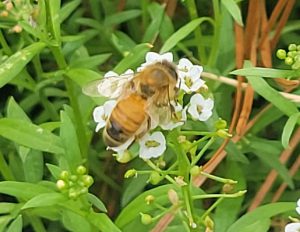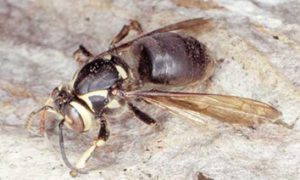Summertime is known for cookouts, barbeque, a stroll through the park or even in your backyard; Be aware of stinging insects. These pests are especially active during the second half of summer and early fall when the colonies forage for food to sustain their queens during the winter. Although many are beneficial pollinators they often pose a danger because of their sting. While some of these stings causes minor reactions, others can pose a serious heath threat, which makes them medically important. These stinging hymenopterans includes wasps, hornets, yellow jackets, velvet ants, Africanized and European honey bee and fire ants.
Unique /Important Traits of this group of insects.
Yellow jackets, paper wasps, and bald-faced hornets can sting multiple times causing allergic reactions. The female velvet ants have a very potent sting that has earned them the nickname “cow-killer.” Unlike Wasps, hornets, and yellow jackets, honey bees only sting once and lose their barbed stinger killing the bee within minutes talk about a sacrifice. Africanized honey bees are dangerous stinging insects that have been known to chase people for over quarter of a mile once they get excited and aggressive, earning the name “killer bee”. Imported fire ants both bite and sting repeatedly, and envenomation (injecting venom) only occurs through the sting.
Solitary vs. Eusocial
Most wasps and bees are solitary – being alone or in solitude, and do not defend their nests, but will sting in defense if caught. On the contrary, the eusocial group, especially ants, bees, and wasps, will display territorial behavior and it is mostly these groups that cause medically significant stings.
What makes Hymenopterans important medically?
Unlike the male, the female Hymenoptera possess specialized stinging apparatus used to inject their venom into prey’s or intruder’s body. Entomologist Justin O. Schmidt’s knows about this all too well, he records his own experience of venomous stings and rate it on a pain scale index ranging from 1- 4, with four being the most painful. It could be life-threatening for people sensitive to the venom. While most stings cause only minor problems, stings cause a significant number of deaths.
What are some possible reactions after the stings?
Local reactions (pain, small edema, redness at the site of the sting); regional reactions, (extensive local swelling, exceeding 10 cm, persisting longer than 24 hours). Systemic anaphylactic responses – most dangerous of the reactions. Symptoms may include itching, rashes or hives, tightness or swelling in the throat, stomach pain, nausea and vomiting and dizziness. More severe cases the individual may experience severe shortness of breath, a drop-in blood pressure, loss of consciousness. Even though some of these reactions are mild about 3% of people ends up the emergency room each year from symptoms related to stings. Some may result in death of the individual.
Treatment/ Preventative Measures
What to do?
Capture the organism, if possible, for identification; allergy desensitization shots; sting removal; hive removal (certified handler); antihistamine (oral or parenteral) and epinephrine by inhalation or epinephrine by injection.
For more information, please contact your local county extension office.
Supporting information for this article can be found in the UF/IFAS EDIS publications/websites below:
Differences Between European and African Honey Bees: IN784-9221465.pdf (ufl.edu); Stinging or Venomous Insects and Related Pests: IG099-D1czi7xu65.pdf (ufl.edu) ;
https://www.ncbi.nlm.nih.gov/pubmed/17265905
https://extension.entm.purdue.edu/publichealth/insects/stinging.htm
- “Stink and Pretty”: The Pedagogy of Marigolds - May 22, 2025
- The Bold and the Beautiful in Your Landscape – Snapdragons - April 10, 2025
- Should You Be Concerned About the Grizzled Mantis? - February 27, 2025



